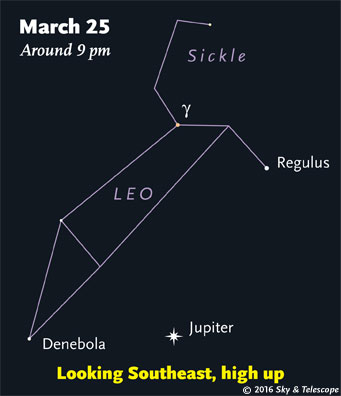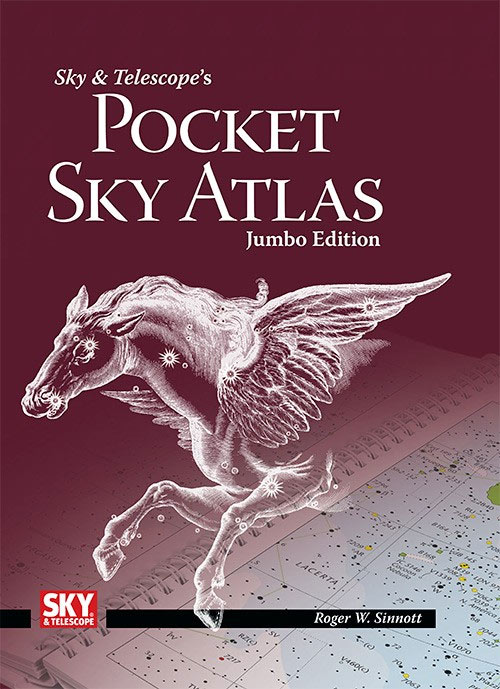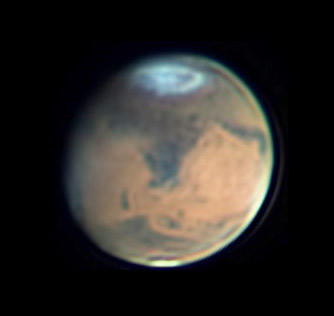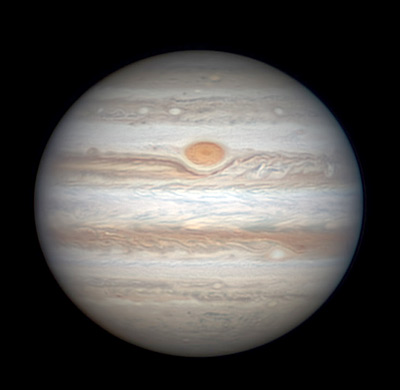Friday, March 18
• As winter turns to spring, Orion declines in the southwest after dark with his Belt roughly horizontal. But when does Orion's Belt appear exactly horizontal? That depends on where you're located east-west in your time zone, and on your latitude. Can you time this event? If you're near your time zone's standard longitude, expect it around 9:15 this evening (daylight-saving time). . . more or less.

Saturday, March 19
• Equinox tonight. Spring begins in the Northern Hemisphere at 12:30 a.m. March 20th Eastern Daylight Time; 9:30 p.m. March 19th Pacific Daylight Time; 4:30 March 20th UT/GMT. This is when the Sun crosses the equator, heading north. In the Southern Hemisphere, fall begins.
Sunday, March 20
• Regulus, brightest star of Leo, stands above the Moon this evening, as shown here. Jupiter is the bright thing farther to the Moon's lower left.
Monday, March 21
• This evening the waxing gibbous Moon forms a smallish triangle with Jupiter and faint little Sigma Leonis, Leo's hind foot (it's 4th magnitude, not shown on the chart). Watch the triangle change shape from hour to hour as the Moon moves eastward along its orbit — and watch the triangle change orientation as it moves across your sky.
Of course they really have nothing to do with each other. The Moon is 1.3 light-seconds from us, Jupiter tonight is 37 light-minutes distant, and Sigma Leonis is 210 light-years in the background.
• Double shadow on Jupiter tonight. Both Io and Europa are casting their tiny black shadows onto Jupiter from 12:23 to 2:31 a.m. Tuesday morning EDT; 9:23 to 11:31 p.m. PDT. Leading the shadows across Jupiter are the satellites themselves, much harder to see against the planet's sunlit disk.
Meanwhile, Jupiter's Great Red Spot should rotate across the planet's central meridian around the middle of this period: around 1:34 a.m. EDT; 10:34 p.m. PDT.
Tuesday, March 22
• Full Moon tonight, and a penumbral lunar eclipse. This is a weak eclipse, with the Moon's southern side skimming only through the pale outer fringe of Earth's shadow (the penumbra). Skywatchers in western North America will see it before dawn Wednesday morning; the eclipse is deepest at 4:47 a.m. PDT; 5:47 a.m. MDT. For Australia and East Asia, the event falls on the evening of March 23rd local date (deepest at 11:47 March 23rd UT/GMT).
Penumbral it may be, but it counts toward your life tally of lunar eclipses you have observed. Fainter penumbral shading may be detectable for nearly an hour before and after the mid-time.
Wednesday, March 23
• As the stars come out this week, Jupiter and Sirius are the two brightest points in the sky — Jupiter in the east-southeast, Sirius toward the south. They'll be at exactly the same height right around nightfall for those of us near latitude 40° north (for example Denver, New York, Madrid). If you're south of there they balance a little later; north of there, a little earlier.

Thursday, March 24
• The Moon, two days past full, rises in the east-southeast around the end of twilight and climbs through the rest of the evening. Spot Spica about 4° to its lower right (for North America), and brighter Arcturus almost 30° to the Moon's upper left.
Friday, March 25
• By about 11 p.m. the bowl of the Big Dipper stands upside down high in the north-northeast, straight over the bowl of the dim Little Dipper as if dumping water into it. They do the reverse in the fall.
Saturday, March 26
• The huge, bright Winter Hexagon is still in view after dark, filling the sky to the southwest and west. Start with brilliant Sirius in the southwest, the Hexagon's lower left corner. High above Sirius is Procyon. From there look even higher for Pollux and Castor, right from Castor to Menkalinen and bright Capella, lower left to Aldebaran, lower left to Rigel at the bottom of Orion, and back to Sirius.
__________________________
Want to become a better astronomer? Learn your way around the constellations. They're the key to locating everything fainter and deeper to hunt with binoculars or a telescope.
This is an outdoor nature hobby. For an easy-to-use constellation guide covering the whole evening sky, use the big monthly map in the center of each issue of Sky & Telescope, the essential guide to astronomy.

Once you get a telescope, to put it to good use you'll need a detailed, large-scale sky atlas (set of charts). The basic standard is the Pocket Sky Atlas (in either the original or new Jumbo Edition), which shows stars to magnitude 7.6.
Next up is the larger and deeper Sky Atlas 2000.0, plotting stars to magnitude 8.5, nearly three times as many. The next up, once you know your way around, is the even larger Uranometria 2000.0 (stars to magnitude 9.75). And read how to use sky charts with a telescope.
You'll also want a good deep-sky guidebook, such as Sue French's Deep-Sky Wonders collection (which includes its own charts), Sky Atlas 2000.0 Companion by Strong and Sinnott, or the bigger Night Sky Observer's Guide by Kepple and Sanner.
Can a computerized telescope replace charts? Not for beginners, I don't think, and not on mounts and tripods that are less than top-quality mechanically (meaning heavy and expensive). As Terence Dickinson and Alan Dyer say in their Backyard Astronomer's Guide, "A full appreciation of the universe cannot come without developing the skills to find things in the sky and understanding how the sky works. This knowledge comes only by spending time under the stars with star maps in hand."
This Week's Planet Roundup


Mercury is hidden in conjunction with the Sun.
Venus (magnitude –3.8) is just barely above the east-southeast horizon 15 or 20 minutes before sunrise. Bring binoculars. Good luck.
Mars (about magnitude –0.2, at the head of Scorpius), rises around 11 or midnight. Before dawn it shines yellow-orange in the south, to the right of Saturn. In a telescope Mars is about 10.5 arcseconds in diameter — big enough to show surface features in a good 3-inch scope at high power during spells of fine seeing.
Jupiter (magnitude –2.5, near the hind foot of Leo) shines in the east-southeast as twilight fades and is highest in the south by 11 or midnight. It sets in the west before sunrise. See our telescopic guide to Jupiter and the daily doings of its four big moons in the March Sky & Telescope, page 48.
Saturn (magnitude +0.4, in the legs of Ophiuchus) rises around midnight lower left of Mars. They're now 11° apart. By early dawn Saturn glows in the south to Mars's left, the two of them forming a triangle with fainter, Mars-colored Antares below them.
Uranus and Neptune are hidden in the glare of the Sun.
__________________________
All descriptions that relate to your horizon — including the words up, down, right, and left — are written for the world's mid-northern latitudes. Descriptions that also depend on longitude (mainly Moon positions) are for North America.
Eastern Standard Time (EST) is Universal Time (UT, UTC, or GMT) minus 5 hours.
__________________________
“This adventure is made possible by generations of searchers strictly adhering to a simple set of rules. Test ideas by experiments and observations. Build on those ideas that pass the test. Reject the ones that fail. Follow the evidence wherever it leads, and question everything. Accept these terms, and the cosmos is yours.”
— Neil deGrasse Tyson
 0
0








Comments
You must be logged in to post a comment.